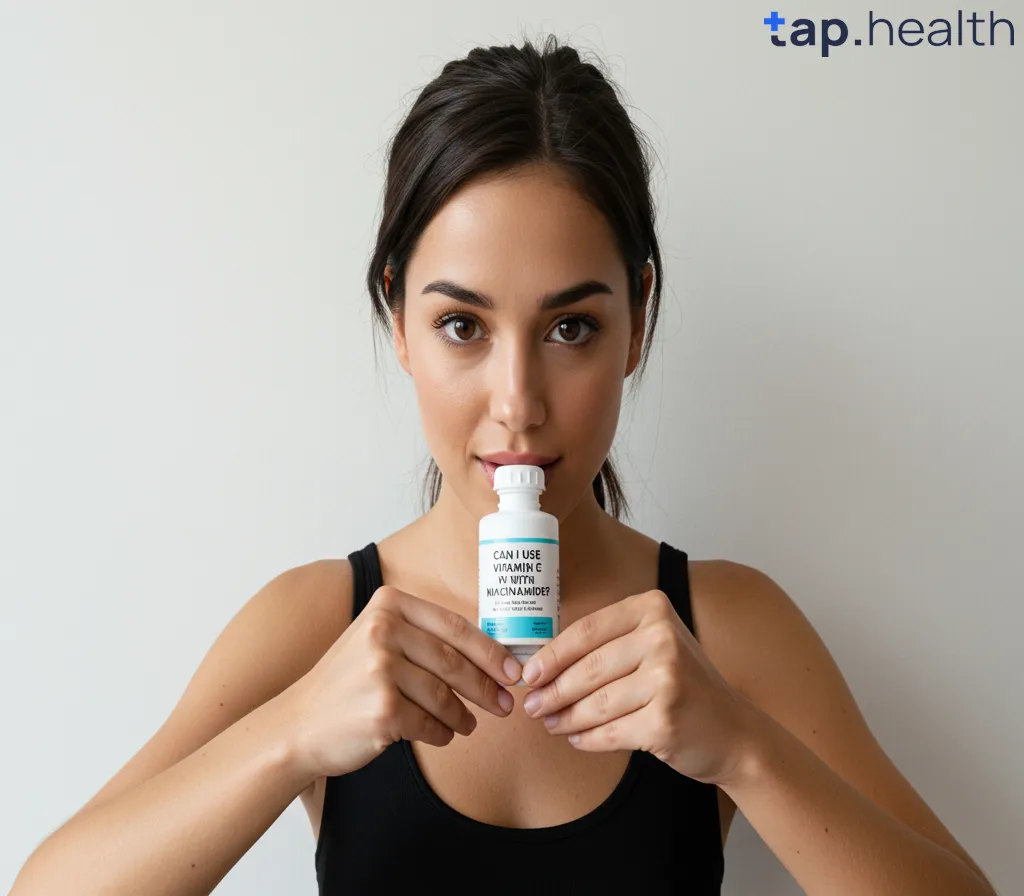You’ve probably heard that vitamin C and niacinamide are two of the most powerful ingredients in skincare. One gives you that bright, sun-kissed glow. The other calms redness, fades dark spots, and keeps your skin strong.
So it makes total sense to want to use them together.
But then you hear things like:
“They cancel each other out.”
“Mixing them turns your skin yellow.”
“You’ll get irritation if you layer them.”
Now you’re stuck. You just want clear, healthy skin. But suddenly, skincare feels like a chemistry test you didn’t study for.
So here’s the real answer:
Yes, you can use vitamin C with niacinamide.
And in most cases, you should.
They don’t fight. They team up.
This guide will walk you through everything in plain, simple language—no confusing jargon, no fake hype. Just honest, easy-to-understand facts based on research from trusted sources like the American Academy of Dermatology, NIH, Cleveland Clinic, and top dermatologists.
Let’s break it all down.
What Is Vitamin C in Skincare?
Vitamin C isn’t just for orange juice. In skincare, it’s one of the most powerful antioxidants you can put on your face.
The most effective form is L-ascorbic acid, but you’ll also see gentler versions like sodium ascorbyl phosphate or magnesium ascorbyl phosphate—especially in formulas for sensitive skin.
Why Is Vitamin C So Good for Skin?
Here’s what vitamin C actually does:
- Brightens dull skin – Gives you that “just got back from vacation” glow.
- Fades dark spots and sun damage – Works on acne scars, age spots, and melasma.
- Protects against pollution and UV rays – Acts like a daily shield (but not a replacement for sunscreen).
- Boosts collagen – Helps skin stay firm and reduces fine lines.
- Calms redness and inflammation – Great for acne-prone or sensitive skin.
Think of vitamin C as your skin’s personal bodyguard. It fights off damage from the environment and keeps your complexion looking fresh and even.
What Is Niacinamide?
Niacinamide (say it like nye-uh-sin-uh-mide) is a form of vitamin B3. It’s not just a trendy ingredient—it’s been studied for decades and proven to help skin in real, measurable ways.
It’s water-based, gentle, and works for almost every skin type: oily, dry, sensitive, acne-prone, aging—you name it.
Why Is Niacinamide So Popular?
Because it does a lot without causing drama.
Here’s what niacinamide helps with:
- Reduces redness and blotchiness – Great for rosacea or irritated skin.
- Fades post-acne marks – Helps even out skin tone over time.
- Strengthens your skin barrier – Keeps moisture in and irritants out.
- Controls oil and minimizes pores – Perfect if you get shiny by noon.
- Helps fight signs of aging – Boosts collagen and keeps skin firm.
It’s like a Swiss Army knife for your face—simple, reliable, and useful in almost every situation.
Can I Use Vitamin C with Niacinamide? The Truth
Yes. You absolutely can.
And not only can you use them together—they actually work better as a team.
But why do so many people think they shouldn’t be mixed?
Let’s go back to the source of the confusion.
The Old Myth That Won’t Die
Back in the 1960s, a lab study found that when niacinamide and vitamin C were heated and exposed to extreme pH conditions, they could form niacin—a compound that can cause facial flushing (redness and warmth).
But here’s the big problem:
That study was done in a test tube under extreme lab conditions—not on human skin and not in real skincare products.
Fast forward to today: modern skincare is formulated to be stable, safe, and effective. Reputable brands test their products to make sure ingredients don’t react badly.
The American Academy of Dermatology (AAD) and top dermatologists like Dr. Dray and Dr. Shereene Idriss confirm:
You can safely use vitamin C with niacinamide.
So the old myth? It’s outdated. Time to let it go.
Why Using Vitamin C with Niacinamide Is a Smart Move
When you pair these two, you’re not doubling up—you’re upgrading.
Here’s how they work together like a dream team:
1. They Fight Dark Spots in Different Ways
- Vitamin C blocks the enzyme (tyrosinase) that makes melanin—the pigment behind dark spots.
- Niacinamide stops that pigment from moving up to the surface of your skin.
So vitamin C stops the factory, and niacinamide stops the delivery truck.
Result? Faster fading of acne scars, sun spots, and melasma.
2. They Strengthen Your Skin in Different Ways
- Vitamin C boosts collagen—the protein that keeps skin firm.
- Niacinamide boosts ceramides—the fats that keep your skin hydrated and protected.
Together, they help your skin stay strong, plump, and less prone to irritation.
3. They Calm Inflammation
Both ingredients reduce redness and swelling. This is great if you deal with:
- Acne
- Rosacea
- Sensitive skin
- Post-breakout marks
Using them together means less irritation and faster healing.
4. They Offer Double Protection
- Vitamin C fights free radicals from sun and pollution.
- Niacinamide helps repair DNA damage and strengthens your skin’s defense.
Pair them, and your skin gets 24/7 protection—even before you apply sunscreen.
Will They Cancel Each Other Out?
No.
This is a common fear, but it’s not supported by science.
Studies from The Journal of Cosmetic Dermatology and real-world use show that vitamin C and niacinamide remain stable and effective when used together in skincare products.
As long as the products are well-formulated (from trusted brands), they won’t neutralize each other.
In fact, some research suggests they may even enhance each other’s effects.
So no, you’re not wasting your money. You’re investing in better skin.
Can I Use Them in the Same Product?
Yes—many brands now make serums that combine both.
These are often labeled as “brightening,” “anti-aging,” or “even tone” formulas.
Examples include:
- Paula’s Choice 10% Niacinamide Booster (can be layered or mixed)
- SkinCeuticals Discoloration Defense (has both vitamin C and niacinamide)
- Olay Regenerist Vitamin C + Niacinamide Moisturizer
- Good Molecules Niacinamide + Vitamin C Serum
Just make sure the product is stored in an opaque, air-tight container—vitamin C breaks down when exposed to light and air.
If the serum turns brown or smells weird, it’s oxidized. Toss it.
How to Use Vitamin C with Niacinamide (3 Safe Ways)
You’ve got options. Pick the one that fits your skin and routine.
Method 1: Layer Them in the Same Routine
This is the most common way.
Rule of thumb: Apply the thinnest product first.
Most vitamin C serums are water-based and go on first.
Steps:
- Cleanse your face.
- Apply vitamin C serum.
- Wait 1–2 minutes for it to absorb.
- Apply niacinamide serum or moisturizer.
- Follow with moisturizer and sunscreen (if it’s morning).
Tip: If your skin stings, try reversing the order. Some people find niacinamide calms the skin, making it more tolerant of vitamin C.
Method 2: Use Vitamin C in the Morning, Niacinamide at Night
This is perfect if you have sensitive or reactive skin.
- AM: Vitamin C + moisturizer + sunscreen
(Vitamin C gives antioxidant protection during the day.) - PM: Niacinamide + night cream
(Niacinamide helps repair and strengthen your skin overnight.)
You still get all the benefits—just spread out over the day.
Method 3: Use a Combo Product
If you want simplicity, go for a serum that has both.
Just check the ingredient list. Avoid products with:
- Alcohol
- Fragrance
- Harsh sulfates
These can irritate your skin and undo the good work of vitamin C and niacinamide.
Can I Use Them If I Have Sensitive Skin?
Yes—but go slow.
Sensitive skin doesn’t mean you can’t use active ingredients. It just means you need to be careful.
Tips for Sensitive Skin:
- Start with lower concentrations:
- Vitamin C: 5–10%
- Niacinamide: 5% or less
- Patch test first—apply behind your ear or on your jawline.
- Introduce one at a time. Wait a week before adding the second.
- Use them every other day at first.
- Avoid combining with exfoliants (like glycolic acid) or retinol at first.
If your skin turns red, itchy, or starts peeling, stop and give it a break. Try gentler versions or talk to a dermatologist.
What Strengths Should I Use?
More isn’t always better. The right strength depends on your skin type and experience.
Vitamin C Strengths:
- 5–10%: Best for beginners and sensitive skin.
- 10–15%: Ideal for most people—effective and well-tolerated.
- 20%+: Strong, but can be irritating. Not needed for most.
A well-formulated 10% serum often works better than a poorly made 20% one.
Niacinamide Strengths:
- 2–5%: Great for dry or sensitive skin.
- 5–10%: Most effective for oily, acne-prone, or aging skin.
- 10%+: Can be drying. Only use if your skin tolerates it.
The Ordinary’s 10% Niacinamide + Zinc is popular, but if it makes your skin flaky, try a 5% version or mix it with a moisturizer.
Can I Use Them with Other Skincare Ingredients?
Yes, but be smart about it.
With Retinol?
Yes, but don’t use them all at once.
Retinol, vitamin C, and niacinamide are all strong. Using all three in one routine can cause irritation.
Better plan:
- AM: Vitamin C + niacinamide + sunscreen
- PM: Retinol (2–3 times a week) + niacinamide or moisturizer
Niacinamide can actually help reduce retinol irritation—so it’s a great partner.
With AHAs or BHAs (like glycolic or salicylic acid)?
Yes, but space them out.
Exfoliants can make your skin more sensitive. If you’re using acids at night, use vitamin C in the morning.
Or, use acids one night and vitamin C the next.
With Hyaluronic Acid or Peptides?
Absolutely. These are gentle and hydrating.
In fact, pairing vitamin C or niacinamide with hyaluronic acid helps prevent dryness and boosts plumpness.
Best Products for Using Vitamin C with Niacinamide
Here are some top-rated, dermatologist-approved options:
1. Paula’s Choice 10% Niacinamide Booster
- Lightweight, fast-absorbing
- Can be mixed with moisturizer or other serums
- Great for oily and acne-prone skin
2. SkinCeuticals C E Ferulic
- One of the most studied vitamin C serums
- Contains vitamin C, E, and ferulic acid for extra protection
- Expensive but effective
- Can be layered with niacinamide
3. The Ordinary Vitamin C Suspension 23% + HA Spheres
- Very strong—best for experienced users
- Gritty texture; use sparingly
- Pair with their Niacinamide 10% + Zinc 1% (but not at the same time if sensitive)
4. Glossier Super Pure Serum
- 5% niacinamide + hyaluronic acid
- Gentle, hydrating, good for sensitive skin
5. Olay Regenerist Vitamin C + Niacinamide Moisturizer
- Affordable and effective
- Combines both actives in a creamy formula
- Great for beginners
Pro Tip: Store vitamin C products in a cool, dark place. Keep the cap on tight. If it turns brown, it’s oxidized—throw it out.
Common Myths—Busted
Let’s clear up the biggest myths so you don’t waste time or money.
Myth: They React and Turn Your Skin Yellow
False. This only happens under extreme lab conditions. It doesn’t occur in real-life skincare use.
Myth: You Should Never Layer Them
False. Layering is safe and effective when done right. Let each product absorb before applying the next.
Myth: Only One Can Work at a Time
False. They work on different pathways. Using both gives you more benefits.
Myth: Vitamin C Is Too Harsh for Daily Use
False. If it’s well-formulated, vitamin C is safe for daily use. Start slow if you’re new.
Myth: Niacinamide Makes You Flush
Only if it turns into niacin—which doesn’t happen in skincare. If you feel warmth, it might be sensitivity, not a chemical reaction.
Signs You Should Stop Using Them
Even safe ingredients can cause issues if your skin says no.
Stop and reassess if you notice:
- Stinging or burning after application
- Redness or rash that doesn’t go away
- Peeling or flaking beyond mild dryness
- Breakouts (could be purging or irritation)
- Worsening of acne or rosacea
If this happens:
- Stop both products for a few days.
- Reintroduce one at a time.
- Use a gentle moisturizer and barrier-repair cream.
- Consider seeing a dermatologist.
Sometimes, the problem isn’t the ingredients—it’s the formula. Fragrance, alcohol, or poor packaging can make even good ingredients irritating.
How Long Until I See Results?
Skincare takes time. Be patient.
Here’s a realistic timeline:
- 2–4 weeks: Less oiliness, fewer breakouts, calmer skin
- 4–8 weeks: Brighter complexion, fading dark spots
- 8–12 weeks: Smoother texture, firmer skin, visible glow
Consistency is key. And always wear sunscreen—UV exposure undoes all the good work vitamin C and niacinamide do.
Can I Use Them During Pregnancy?
Yes, both are generally considered safe during pregnancy.
- Niacinamide: Safe, non-hormonal, great for pregnancy acne and melasma.
- Vitamin C: Also safe and helpful for brightening pregnancy-related dark spots.
But always check with your doctor before starting new skincare, especially if you’re using prescription products.
Avoid formulas with retinoids or hydroquinone during pregnancy.
Can Teens Use Vitamin C with Niacinamide?
Yes—especially for acne and dark marks.
Teens often deal with:
- Breakouts
- Post-acne spots
- Oily skin
Niacinamide helps control oil and reduce inflammation. Vitamin C fades scars and brightens skin.
Just use gentle formulas and avoid high concentrations at first.
Can Men Use These Ingredients?
Absolutely.
Skincare isn’t just for women. Men can benefit from vitamin C and niacinamide too—especially for:
- Razor burn
- Ingrown hairs
- Dark spots
- Dullness
- Aging signs
These ingredients are gender-neutral and work the same on all skin types.
Can I Use Them in the Summer?
Yes—and you should.
Summer means more sun, pollution, and sweat—all of which damage your skin.
- Vitamin C protects against UV and pollution.
- Niacinamide helps control oil and prevent breakouts.
But always wear sunscreen. Vitamin C makes your skin more sensitive to the sun.
What If I’m Using a Vitamin C Serum That Stings?
Some stinging is normal with strong vitamin C, especially if you have sensitive skin.
But if it burns or turns your skin red, it might be:
- Too high a concentration
- Poorly formulated
- Combined with other actives
Try:
- Using it every other day
- Applying it after moisturizer (buffering)
- Switching to a gentler form (like magnesium ascorbyl phosphate)
Can I Use Them with a Facial Roller or Gua Sha?
Yes.
Using a jade roller or gua sha with vitamin C and niacinamide is fine.
Just make sure to:
- Clean your tools regularly
- Use gentle pressure
- Don’t over-scrub irritated skin
It can actually help with absorption and circulation.
Final Tips for Best Results
Want real results? Follow these simple rules:
- Start slow – Introduce one product at a time.
- Use sunscreen daily – UV rays undo the brightening effects.
- Store products properly – Keep vitamin C away from light and air.
- Don’t overdo it – One vitamin C and one niacinamide product are enough.
- Listen to your skin – If it feels tight or red, scale back.
- Be consistent – Results come with regular use.
Frequently Asked Questions (FAQ)
Can I use vitamin C with niacinamide every day?
Yes, most people can use both daily. Start every other day if you have sensitive skin.
Can I mix them in my hand before applying?
Not recommended. Mixing can affect stability. Layer them instead.
Does niacinamide make vitamin C less effective?
No. They remain effective when used together in skincare.
Can I use them if I have acne?
Yes. Both help with acne, oil control, and fading scars.
Which should I apply first?
Apply the thinnest product first—usually vitamin C. If it stings, try niacinamide first.
Can I use them with sunscreen?
Yes! Apply vitamin C in the morning, then niacinamide (if using), then moisturizer, then sunscreen.
Do they expire?
Yes. Vitamin C oxidizes (turns brown) in light and air. Use within 3 months of opening.
Can they cause purging?
Not usually. Purging is linked to exfoliants like retinoids or acids.
Is it safe to use with other vitamins?
Yes. They work well with vitamins E, B5, and A (retinol)—just don’t overload your skin.
Can I use them if I have rosacea?
Yes, but start with low concentrations. Niacinamide is especially helpful for redness.
What if my skin feels dry?
Add a hydrating serum or moisturizer. Both ingredients can be drying at high strengths.
Can I use them in the summer?
Yes, but always wear sunscreen. Vitamin C increases sun sensitivity.
Can I use them with a jade roller or gua sha?
Yes. Just clean your tools regularly to avoid bacteria.
Do I need both if I only have one concern?
Even if you only want to fade dark spots, using both gives faster, longer-lasting results.
Can I use them if I’m over 50?
Yes. Both help with aging skin—collagen loss, dark spots, and dullness.
Can I use them with a clay mask?
Yes, but not at the same time. Use the mask first, let skin calm down, then apply your serums.
The Bottom Line
So, can you use vitamin C with niacinamide?
Yes.
They don’t fight. They work together.
They don’t cancel each other out. They boost each other.
And when used the right way, they can transform your skin—making it brighter, clearer, and stronger.
Forget the myths. Trust the science. Listen to your skin.
Start slow. Be consistent. Protect with sunscreen.
And get ready to glow—naturally.



